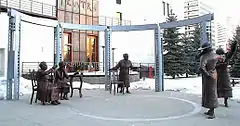The Famous Five (Canada)
The Famous Five (French: Célèbres cinq), also known as The Valiant Five,[1] and initially as The Alberta Five, were five prominent Canadian suffragists who advocated for women and children.[2] They asked the Supreme Court of Canada to answer the question, "Does the word 'Persons' in Section 24 of the British North America Act, 1867, include female persons?" in the case Edwards v Canada. The five women, Emily Murphy, Irene Marryat Parlby, Nellie Mooney McClung, Louise Crummy McKinney and Henrietta Muir Edwards, created a petition in an effort to have women considered legally as a person, so that women could be appointed to the Senate.
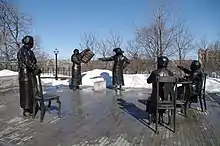
The petition was filed on August 27, 1927, although the Supreme Court of Canada passed a decision that women are not such persons. This judgement was overturned by the British Judicial Committee of the Privy Council on October 18, 1929. This case came to be known as the "Persons Case". Although Canadian women (those who were British/Canadian citizens) had the vote in many provinces and in federal elections by 1929, the case was part of a larger drive for political equality.
Some saw this as "radical change"; others saw it as a restoration of the original framing of the English constitutional documents, including the 1689 Bill of Rights, which uses only the term person, not the term man (or woman for that matter). Some others have interpreted the Privy Council rule as causing a change in the Canadian judicial approach to the Canadian constitution, an approach that has come to be known as the "living tree doctrine".
History
From 1917 to 1927, successive Canadian governments have suggested that they wanted to appoint a woman to the Senate, although all have pointed out that section 24 of the British North America Act, 1867 made it impossible.[3] In August 1927, Emily Murphy invited four women activists; including Nellie McClung, Irene Parlby, Louise McKinney and Henrietta Muir Edwards to her home in Edmonton. The group, later known as the Famous Five, discussed plans to petition the Canadian government to submit a reference question to the Supreme Court of Canada regarding the interpretation of the word persons in the British North America Act.[3] Under section 60 of the British North America Act, the government may be directed to seek an interpretation of the constitution from the supreme court, if it receives a petition to do so from at least five people.[3]
.jpg.webp)
On 27 August 1927, a petition was sent to the Governor General of Canada, signed by the Famous Five.[4] The petition requested that the government ask the supreme court if power was vested in the governor general in council, the prime minister of Canada, or both, to appoint a woman to the Senate of Canada; and if it was constitutionally possible to make provisions that would allow for the appointment of a woman.[3] In response to the petition, the Canadian government brought forward the question "if the term persons in section 24 of the British North America Act, 1867, include female persons" to the supreme court.[3] On 24 April 1928, a decision was made by the supreme court that the word persons in the British North America Act did not encompass women. The ruling was based on the premise that the term should be interpreted in the same way as in 1867, and that the act would have specifically mentioned women if they had meant to make an exception for the Senate.[5]
The decision of the supreme court was later successfully appealed by the five through the Judicial Committee of the Privy Council.[3] The decision was overturned on 18 October 1929, where it concluded that the term persons does encompass women. John Sankey, 1st Viscount Sankey, the justice who delivered the judgement, noted that,
[The] exclusion of women from all public offices is a relic of days more barbarous than ours […] their Lordships do not think it right to apply rigidly to Canada of to-day the decisions and the reasonings therefor which commended themselves […] to those who had to apply the law in different circumstances, in different centuries, to countries in different stages of development.
— John Sankey, 1st Viscount Sankey, [3]
As a result of the decision, women were legally recognized as persons, and may no longer be denied their rights based on a narrow interpretation of the term. The decision also provided another step towards gender equality, with women now able to pursue legislative recourse through the Senate.[3]
The Five
The Famous Five included Emily Murphy, Henrietta Muir Edwards, Nellie McClung, Louise McKinney, and Irene Parlby. The five women had spent a number of years active in several women's suffragettes movements dating back to the 1880s and 1890s.[6] As group first convened in Alberta, the five were initially referred to as The Alberta Five by the media. However, as a result of the group's importance to Canada as a whole, the group was eventually referred to as The Famous Five.[6]
Emily Murphy
Emily Murphy stood out in the famous five, as the British Empire's first female judge. Emily was appointed to the office of Magistrate of the Edmonton Juvenile Court in 1916 and later became the magistrate of the newly created Women's Court. At the time, no woman had held such a position and many men objected.[7]
During her career as a writer, Murphy used the pen name "Janey Canuck". In 1922, she wrote The Black Candle which detailed her beliefs on race and drug use in Canada and strongly influenced the drug policy of the day.[8]
Henrietta Muir Edwards
Henrietta Muir Edwards, author and researcher on women's topics, held an influence within the National Council of Women of Canada[5] and held chairmanship of the Committee in Law in the National Council of Women for more than 35 years. She was also a Red Cross leader during the war years. Edwards was the secretary of the National Subcommittee which focused on thrift and economy in Canadian homes.[7] She was also a founding member of the Victorian Order of Nurses.
Nellie McClung
Nellie McClung's jobs in her lifetime included teacher, author, public speaker, temperance activist, internationally known women's rights activist, and politician {Warne, Literature as Pulpit]. In 1918, she was a member of the Dominion War Council and the only woman representative at the League of Nations. McClung famously said "I‘ve never thought minding my own business is much of a virtue. Too often it‘s just an excuse for not taking action when action needs taking!".[2] She represented Canada at the Ecumenical Council of the Methodist church in 1921 and was the first woman on the Canadian Broadcasting Corporation Board of the Governors.[7] In 1921, McClung was elected to the Alberta legislature as an MLA in Edmonton for the Liberal Party.[8] She served one term, not being re-elected in 1926. She was a member of the Political Equality League of Manitoba, and she played the leading role in the Mock Parliament held on January 29, 1914, at the Walker Theatre in Winnipeg, which humorously discussed Votes for Men.[7]
Louise McKinney
Louise McKinney became one of the first two women elected to a legislature in the British Empire, and the first to take her seat. She was a founder of the Woman's Christian Temperance Union in Alberta and the West – she served as the organization's vice-president for more than 22 years beginning in 1906 – and regularly attended World Meetings of the WCTU. She signed the appeal to the Privy Council in 1929. In 1931, she became president of the Canadian Union, Woman's Christian Temperance Union. McKinney was also named to be Commissioner for the first General Council of the United Church of Canada, and was the only woman to sign the Basis of Union.[7]
Irene Parlby
In 1916, Irene Parlby was elected as the first president of the United Farm Women of Alberta and in 1921, was elected to the Alberta legislature and received a cabinet post in the United Farmers of Alberta government, becoming the second woman in the British Empire to hold ministerial rank. She was also the first female Cabinet minister in Alberta, and still serving in that capacity at the time of the court case. She served as cabinet minister until the downfall of the government in 1935. Parlby worked with the Red Cross during World War I and later served on the Board of Governors of the University of Alberta.[7]
Legacy
Honorary senators
None of the five became senators; the first female senator was Quebecer Cairine Reay Wilson, appointed four months after the ruling. Nearly 80 years later, on October 8, 2009, the Senate voted to make the five the first "honorary senators".[9][10] The achievement of personhood for women had been a monumental change which gave more power to women.
Some might well question the overall significance of the decision, noting that by the 1920s the Senate of Canada was a largely powerless body. The more powerful House of Commons of Canada had elected its first female member (Agnes Macphail) in 1921, well before the Persons Case. However, the precedent did establish the principle that women could hold any political office in Canada. Moreover, the Five clearly did devote their energies to increasing women's participation on legislative bodies with greater power: three had been members of the Alberta legislature. The controversy surrounding the women has made commemoration difficult. The five women were activists in a variety of areas in their pursuit to better the conditions for women and children.
Opinions on the Famous Five
Opinions on the Famous Five vary considerably. Many laud them as trailblazers for women. Others are disturbed by the opinions of some of the women on other issues, such as opposition to non-white immigration and their successful campaigns to have eugenics legislation introduced in Canadian provinces, which resulted in the sterilization of thousands of those deemed "mentally deficient" or "insane" in Alberta and elsewhere.[11] Emily Murphy was not shy with her opinions and her outspoken nature had a tendency to give her a negative reputation. She wrote letters of her opinions to police chiefs, government officials, social service agencies and judicial officials about the extent of drug traffic and possible cures. Nellie McClung was known as the most memorable and popular of the famous five. Her causes included women's right to vote, prohibition, women in the church and women in public life.[8] Henrietta Muir Edwards was described as "tenacious" with her work with prohibition.[7]
The five women were activists in a variety of areas in their pursuit to better the conditions for women and children. Emily Murphy dealt with single mothers and issues of child support, child welfare, and adoption by lobbying for women's rights.[12] Nellie McClung favoured free medical and dental treatment for school children as well as mothers' allowances and better property rights for women. She was open to divorce and birth control but opposed the sale and use of liquor. Louise McKinney believed strongly in the "evils of alcohol" and pushed to enact prohibition measures. She advocated excluding cigarettes from parcels sent to soldiers in World War I in 1917. She supported reasonable measures for social welfare and health as well as introducing bills intended to make prohibition more effective, to improve the lot of immigrants and bring better security to widows. She was responsible for the introduction of a motion which led to the Dower Act. Irene Parlby in her position as cabinet minister in Alberta pursued these goals expressed by McKinney. Henrietta Edwards worked with property law and sought to protect women and children.[8]
Commemorations
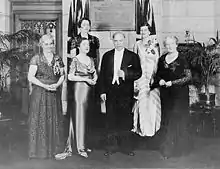
The Famous Five have been commemorated with individual and group plaques in the foyer and antechamber of Canada's Senate, and two identical sculptures by Canadian artist Barbara Paterson, one on Parliament Hill in Ottawa, the other at the Olympic Plaza in Calgary. The sculpture on Parliament Hill was unveiled on October 18, 2000, in a public ceremony that included French and English singers, Inuit dancers, and speeches by Governor General Adrienne Clarkson and Prime Minister Jean Chrétien. A sculpture of the Famous Five by sculptor Helen Granger Young stands on the grounds of the Manitoba Legislature in Winnipeg. Commissioned by the Nellie McClung Foundation, it was unveiled at a ceremony on June 18, 2010.
The City of Edmonton has named one park in its River Valley Parks System after each of the "Famous Five".[13]
Murphy had many accomplishments, such as becoming the first president of the Federated Women's Institute of Canada, vice-president of National Council of Women of Canada, president of Canadian Women's Press Club, director of the Canadian Council of Child Welfare, vice-president of the Canadian Association of Child Protection, first president of the Women's Canadian Club of Edmonton and vice-president of the Social Service Council of Canada. Emily Murphy also received many honours for her life's work including being decorated by King George V to be a Lady of Grace of the Order of St. John of Jerusalem.
Irene Parlby was honoured in 1935 at spring convocation at the University of Alberta with an honorary LL.D. degree. Tributes in honour of Henrietta Edwards can be found on a plaque in the Senate Chamber in Ottawa and another in the post office in Fort Macleod. Nellie McClung spoke in Calgary after Edwards' passing and spoke of Edwards, "who for 40 years was convener of laws for the National Council of Women" should not be forgotten.[7]
Along with Thérèse Casgrain, the Five were commemorated in the 2001 Journey Series of Canada's fifty-dollar bill.[5] In December 2011, the Bank of Canada announced that the Famous Five would not appear on the redesigned $50 Frontier Series banknote that it issued in 2012.[14]
The achievement of personhood for women had been a monumental change which gave more power to women. To honour the Five and continue to involve women in leadership roles in Canada, Frances Wright and others established the non-profit Famous Five Foundation on October 18, 1996, the 70th anniversary of the Judicial Committee of the Privy Council's decision.[15]
See also
References
- Kome, Penney (1985). Women of Influence: Canadian Women and Politics (1st ed.). Toronto: Doubleday Canada. pp. 31–32. ISBN 978-0-385-23140-4.
- "The Story". Famous 5. Retrieved March 25, 2019.
- Marshall, Tabitha; Cruickshank, David A. (October 18, 2019). "Persons Case". The Canadian Encyclopedia. Historica Canada. Retrieved August 10, 2020.
- Alberta History. 47–49. Historical Society of Alberta. 1999. Retrieved May 10, 2013.
- Brennan, Brian (2001). Alberta Originals: Stories of Albertans Who Made a Difference. Fifth House. p. 14. ISBN 1-894004-76-0.
- Cavanaugh, Catherine (June 4, 2015). "Famous Five". The Canadian Encyclopedia. Historica Canada. Retrieved August 10, 2020.
- MacEwan, Grant (1975). ...and Mighty Women too: Stories of Notable Western Canadian Women. Western Producer Prairie Books. ISBN 978-0-9193-0665-3.
- Millar, Nancy (1999). The Famous Five: Five Canadian Women and Their Fight to Become Persons. Western Heritage Centre. ISBN 978-0-9201-0916-8.
- "'Famous 5' named honorary senators". CBC News. October 10, 2009. Retrieved May 10, 2013.
- "The Senate: Motion to Recognize "Famous Five" as Honorary Senators Adopted". Senate of Canada. October 8, 2009.
- Marsh, James H. (March 4, 2015). Eugenics: Pseudo-Science Based on Crude Misconceptions of Heredity. The Canadian Encyclopedia.
- Sharpe, Robert J. (2007). The Persons Case: The Origins and Legacy of the Fight for Legal Personhood. University of Toronto Press. ISBN 978-0-8020-9628-9.
- "Alphabetical Park Listing". City of Edmonton. May 14, 2012. Archived from the original on November 27, 2012. Retrieved May 14, 2012.
- "Should the new $50 bill show an Arctic research boat instead of the Famous Five?". CBC News. December 7, 2011. Retrieved May 17, 2013.
- "About Us". Famous 5 Foundation. Archived from the original on December 25, 2012. Retrieved May 17, 2013.
External links
| Wikimedia Commons has media related to The Famous Five. |
- The Famous Five from the National Archives of Canada
- Supreme Court of Canada opinion in the "Persons Case" (from CanLII)
- Judicial Committee of the Privy Council opinion in the "Persons Case" (PDF)
- JCPC opinion (unofficial version from Canadian Human Rights Commission)
- Canadian Encyclopedia entry Catherine Cavanaugh 06/01/2006
- Famous 5 Foundation
- The Famous 5 Monument video and essay in the Virtual Museum of Canada

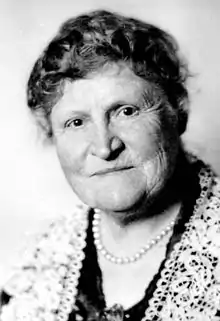
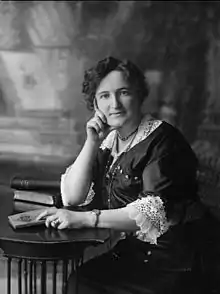
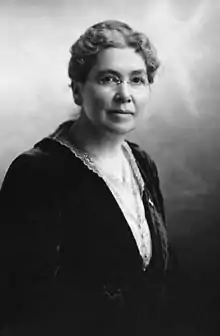
_(16661079517).jpg.webp)
